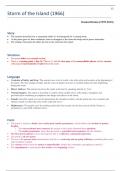12
Storm of the Island (1966)
Seamus Heaney (1939-2013)
Story
• The narrator describes how a community think it’s well prepared for a coming storm.
• As the poem goes on, their confidence starts to disappear as the storm develops and its power intensifies.
• The ending of the poem describes the fear as the storm hits the island.
Structure
• The poem shifts from security to fear.
• There is a turning point in line 14 (“But no”), with the slow pace of the monosyllabic phrase and the caesura
reflecting the last moments of calm before the storm.
Language
• Contrasts of Safety and Fear: The narrator uses a lot of words to do with safety and security at the beginning of
the poem. The tone changes though, and the sense of danger increases as familiar things become frightening
during the storm.
• Direct Address: The narrator involves the reader in his fear by speaking directly to “you”.
• Violent Imagery: The storm is described in violent, often warlike terms, with similes, metaphors and
personification combining to emphasise the danger and effects of the storm.
• Sounds: Forceful sounds are used to demonstrate the strength of nature, and the poem also uses assonant and
sibilant sounds to reflect the noise of the wind and waves.
• Helplessness: The people can’t do anything about their fear except wait for the storm to finish. Nature is
presented as a powerful, relentless force.
Form
• The poem is written in blank verse (unrhymed, iambic pentameter), which follows the rhythm of spoken
English.
o The conversational tone connects the speaker to the reader (demands their attention).
o The iambic pentameter shows that the poem is controlled and organised, like the islanders.
• The first person plural is used, showing how this is a collective, communal experience.
• The poem is all one stanza.
• The use of the present tense demonstrates that this is a recurring and on-going suffering (something that occurs
often and hasn’t ended).
• The caesura reflects how the nature is unpredictable, despite the community attempting to control it.
• The enjambment is used to place key words at the beginning of lines.




